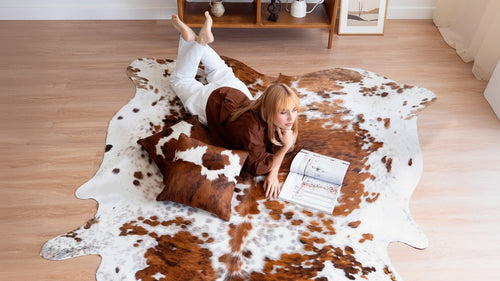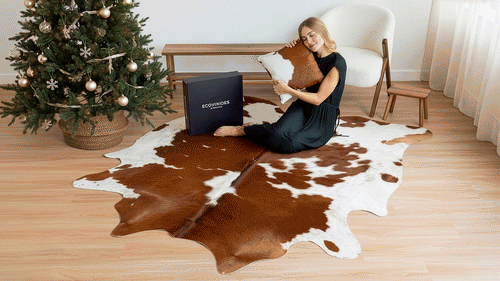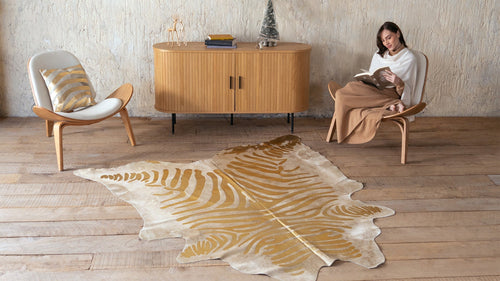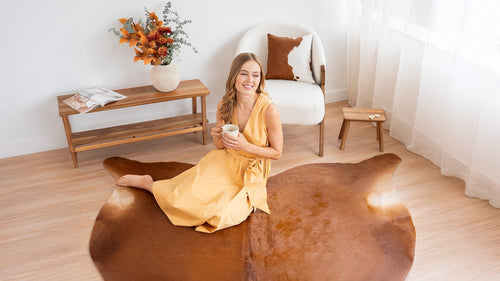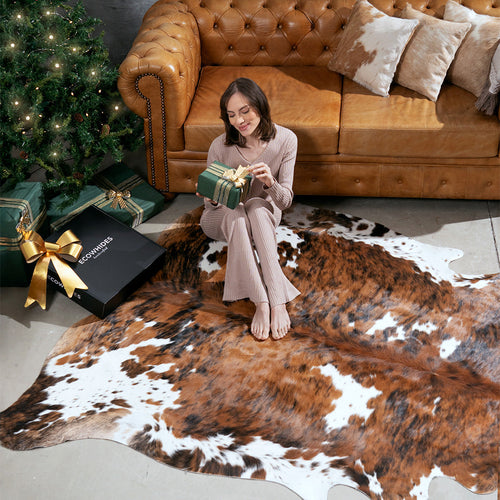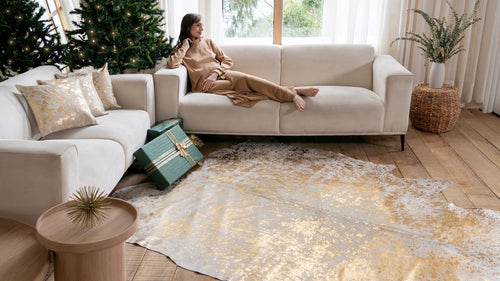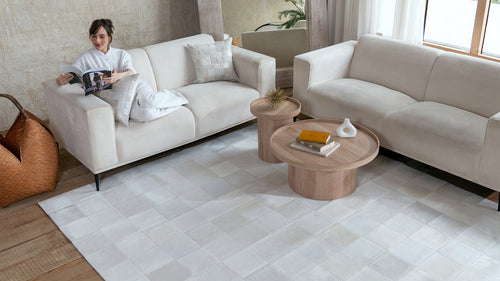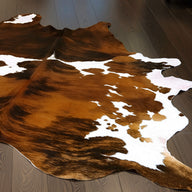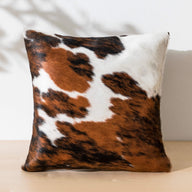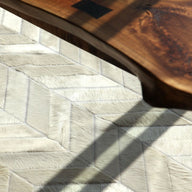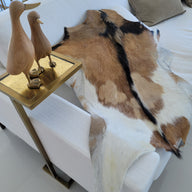In the realm of home decor, few elements possess the power to transform a space quite like a Cowhide Rug. These unique pieces not only add warmth and texture to a room but also serve as a testament to craftsmanship and heritage. For those who seek to create a home that's more than just a house, understanding the journey from hide to rug can deepen appreciation for these remarkable floor coverings.
The art of creating Cowhide Rugs is a process steeped in tradition, yet refined by modern techniques. It's a craft that requires skill, patience, and a profound respect for the materials involved. Let's embark on a journey through the fascinating world of Cowhide Rug production, exploring each step that brings these beautiful pieces to life.
The Origin Story: More Than Just a Hide
Before we delve into the production process, it's crucial to understand where these hides come from at eCowhides. Contrary to common misconception, the Cowhides used in rug making are not sourced solely for this purpose. Instead, they are salvaged from animals raised primarily for the meat industry. This approach aligns with a philosophy of resource maximization and waste reduction, ensuring that every part of the animal serves a purpose.
However, not all Cowhides are created equal. The finest rugs, like those crafted by eCowhides, come from Grade-A hides. These premium-quality hides are individually sourced, allowing for meticulous selection and traceability. This level of care in sourcing sets the foundation for creating rugs that speak of class and quality.
Step 1: Sourcing and Selection
The journey begins in the lush pastures of countries known for their superior cattle, such as Brazil. Here, skilled buyers with an eye for quality handpick each hide. They look for hides with minimal blemishes, consistent coloration, and a healthy, lustrous appearance. This careful selection process ensures that only the best raw materials make it to the next stage.
It's worth noting that responsible sourcing goes beyond just quality. Leading producers, including eCowhides, work exclusively with tanneries certified by the Leather Working Group (LWG). This certification is a comprehensive assessment of environmental performance and compliance in leather manufacturing facilities. It evaluates tanneries on multiple fronts, including water and energy usage, waste management, air emissions, and chemical handling. By choosing LWG-certified sources, producers demonstrate a commitment to sustainability and ethical practices in the industry.
Step 2: Initial Processing
Once selected, the hides undergo initial processing. This involves cleaning the hides thoroughly to remove any dirt, debris, or excess tissue. The hides are then trimmed to remove any damaged areas, ensuring that only the highest quality portions are used for rug making.
This stage also includes an initial assessment of each hide's natural patterns and colorations. Some hides boast striking natural designs, like the popular Tricolor patterns, while others may have more subtle variations. These natural characteristics play a crucial role in determining the final appearance and value of the rug.

Step 3: Tanning - Where Art Meets Science
Tanning is perhaps the most critical step in the Cowhide Rug production process. It's here that raw hides are transformed into durable, supple leather that will stand the test of time. The tanning process has evolved over centuries, combining traditional knowledge with modern techniques to produce superior results.
The primary goal of tanning is to stabilize the collagen structure of the hide, preventing decomposition and creating a material that's resistant to water, bacteria, and heat. This is achieved through a carefully orchestrated series of chemical reactions that permanently alter the protein structure of the hide.
The art of tanning requires a delicate balance. Too little tanning can result in a hide that's prone to decomposition while over-tanning can lead to a stiff, inflexible product. Master tanners, like ours at eCowhides, have honed their craft over generations, perfecting the process to produce hides that are not only durable but also retain their natural beauty and suppleness.
Step 4: Dyeing and Finishing
While many Cowhide Rugs showcase their natural colors, some undergo dyeing to achieve specific hues or patterns. This step allows for the creation of diverse collections, from vibrant dyed tones to bold metallic finishes and even animal print designs.
The dyeing process is an art form in itself. Skilled artisans use a combination of dyes and techniques to achieve the desired colors while maintaining the hide's natural patterns. For metallic Cowhides, for example, specialized treatments are applied to create a shimmering effect without compromising the leather's integrity.
After dyeing, the hides undergo a finishing process. This may involve treatments to enhance softness, improve water resistance, or add a particular sheen. The goal is to bring out the best qualities of the hide while ensuring it can withstand the rigors of daily use as a rug.
Step 5: Cutting and Shaping
Once the hides are tanned, dyed, and finished, they're ready to be transformed into rugs. This stage requires a keen eye and steady hand, as each hide is unique in shape and size.
For traditional Cowhide Rugs, the natural shape of the hide is often preserved, celebrating its organic form. However, for specialized designs like Patchwork Area Rugs or the exclusive Texas Cowhide Star Round Rugs, precise cutting is essential.
Skilled craftsmen use specialized tools to cut the hides according to predetermined patterns. In the case of Patchwork Rugs, multiple hide pieces are carefully selected and cut to create a cohesive design when assembled. This process allows clients to collaborate with our experts to create custom-sized pieces tailored to their needs and personal style.
As for our exclusive star design, each rug is handcrafted by skilled artisans who meticulously match five premium cowhides, combining colors with precision to create a durable, one-of-a-kind statement piece that reflects Texas heritage. Every patch is carefully stitched, ensuring the final product matches the image you see and stands the test of time.

Step 6: Assembly and Backing
For standard Cowhide Rugs, this step is relatively straightforward, as the natural hide forms the rug itself. However, for more complex designs like patchwork rugs, this stage involves carefully piecing together the cut sections.
The assembly process is a testament to the skill of the artisans. Each piece must be perfectly aligned and securely joined to create a seamless final product. This is where the heritage of craftsmanship truly shines, as techniques passed down through generations are combined with modern methods to create rugs of exceptional quality.
Once assembled, the rugs are typically backed with a durable material. This backing serves several purposes: it adds stability to the rug, prevents curling at the edges, and provides a smooth surface that won't scratch delicate flooring. The choice of backing material can affect the rug's performance, with high-quality backings enhancing durability and preventing slippage.

Step 7: Final Inspection and Quality Control
Before a cowhide rug is ready for its new home, it goes through a thorough quality control process. Our expert inspectors carefully examine every inch, checking for any imperfections in the hide, ensuring the color is consistent, and verifying that all seams in patchwork designs are secure and properly aligned.
At eCowhides, our meticulous inspection process is essential to upholding our reputation for premium cowhide rugs. It ensures that every rug leaving our workshop meets the highest standards of quality and craftsmanship.
The Finished Product: More Than Just a Rug
The result of this intricate process is far more than just a floor covering. Each Cowhide Rug is a unique piece of functional art, bearing the imprint of nature's design and human craftsmanship. These rugs are not mass-produced items, but rather individual creations, each telling its own story.
When you bring a Cowhide Rug into your home, you're not just adding a decorative element; you're introducing a piece of history, tradition, and artistry. The natural variations in color and pattern ensure that no two rugs are exactly alike, allowing homeowners to own a truly one-of-a-kind piece.

Versatility in Design: Beyond Western Decor
One common misconception about Cowhide Rugs is that they're suitable only for western-themed decor. While they certainly complement rustic and western styles beautifully, the truth is that Cowhide Rugs are remarkably versatile and can enhance a wide range of interior design aesthetics.
In contemporary settings, a Cowhide Rug can add an organic element that softens modern lines and brings warmth to minimalist spaces. In eclectic interiors, it can serve as a statement piece, adding texture and visual interest. Even in traditional rooms, a well-placed Cowhide Rug can introduce a touch of the unexpected, creating a dynamic contrast with classic furnishings.
The adaptability of Cowhide Rugs extends beyond floor use. Creative decorators have found numerous ways to incorporate these versatile pieces into their homes:
- As a throw over a sofa or chair, adding instant texture and coziness
- Draped over a banister or railing for a unique architectural accent
- Hung on a wall as a striking piece of natural art
- Layered over other rugs to create depth and interest in a room
- Used as a headboard for a rustic yet luxurious bedroom focal point
This flexibility in application makes Cowhide Rugs a favorite among interior designers and homeowners who want to create spaces that are both stylish and personal.
Durability and Maintenance: Built to Last
One of the most appealing aspects of Cowhide Rugs is their durability. When sourced from high-quality hides and properly tanned, these rugs can withstand heavy foot traffic and maintain their beauty for years. Unlike many synthetic rugs that may shed or wear quickly, a well-made Cowhide Rug is resistant to shedding and can actually become softer and more supple with use.
Maintaining a Cowhide Rug is surprisingly simple. Regular vacuuming (using a brush attachment) is usually sufficient to keep the rug clean and looking its best. For spills, a damp cloth can be used to blot the area gently. It's important to avoid soaking the hide or using harsh chemicals, as these can damage the hide.
One of the hidden benefits of Cowhide Rugs is their natural resistance to allergens. The tanning process makes the hide inhospitable to dust mites and other common household allergens, making these rugs an excellent choice for allergy sufferers.
The Heritage Behind the Craft
The creation of our Cowhide Rugs is more than a manufacturing process—it's a craft deeply rooted in tradition and heritage. This legacy is central to our identity and guides our commitment to exceptional craftsmanship.
At eCowhides, our story began nearly two decades ago when our founder set out on a journey through Colombia to discover the best hides and tanning techniques, guided by knowledge passed down from his father and grandfather. By blending traditional craftsmanship with modern innovation, we’ve developed Cowhides that are both beautiful and durable. Our close partnerships with artisans in Colombia and Brazil’s top tanneries allow us to combine time-honored techniques with cutting-edge processes.
Behind every Cowhide Rug is a team of skilled artisans—from tanners who transform raw hides into supple leather to craftspeople who cut and assemble intricate designs. Their technical expertise, passion for the craft, and pride in creating exceptional products are at the heart of what we do.
Our dedication to craftsmanship and quality has earned us a reputation for excellence. Our Cowhide Rugs are celebrated not just for their beauty, but for the skill and care that go into every piece.

Choosing Your Perfect Cowhide Rug
With an understanding of the intricate process behind Cowhide Rug production, you're well-equipped to choose the perfect piece for your home. Here are some factors to consider:
- Color and Pattern: From classic Brown and White to bold Tricolors or even Metallic finishes, choose a rug that complements your existing decor or serves as a striking focal point.
- Size and Shape: Consider the space where the rug will be placed. Natural Cowhide shapes can add organic flair, while exclusive shapes like our Texas Cowhide Star Round Rugs can create a more deliberate design statement.
- Purpose: Will the Cowhide Rug be a central piece in a living room, a cozy addition to a bedroom, or a unique wall hanging? The rug's intended use can guide your choice.
- Quality: Look for Grade-A hides from reputable producers. These will offer the best durability and appearance over time.
- Sustainability: If environmental concerns are important to you, seek out producers who use LWG-certified tanneries and follow responsible sourcing practices.
A Cowhide Rug is more than just a decorative element; it's a piece of functional art that brings warmth, texture, and a touch of nature into your living space. Understanding the intricate process behind its creation - from careful sourcing to skilled craftsmanship - allows you to appreciate the true value of these unique pieces.
Whether you're drawn to the classic elegance of a natural Cowhide, the bold statement of a Dyed or Animal Print design, or the intricate artistry of a Patchwork creation, there's a Cowhide Rug to suit every taste and interior style. By choosing a high-quality piece from a reputable producer, you're not just purchasing a rug; you're investing in a timeless addition to your home that will continue to delight for years to come.
As you walk across your Cowhide Rug or admire it from across the room, remember the journey it has taken - from pasture to living room floor. In its supple texture and unique patterns, you'll find a connection not just to nature, but to a rich tradition of craftsmanship and a commitment to quality that spans generations. This is the true beauty of a Cowhide Rug - a perfect blend of nature's artistry and human skill, creating a unique piece that turns a house into a home.



















